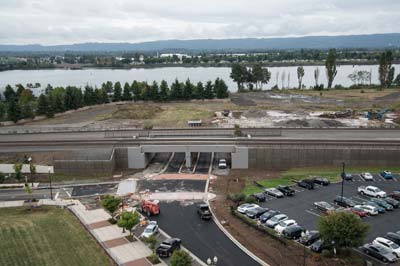It’s a jumble of asphalt and rutted grass west of interstate 5, once home to a lumber mill and now long vacant. But the planners and developers who’ve put millions of dollars into redeveloping downtown Vancouver’s waterfront – and who plan to spend more than a billion more – see something else when they look at the 32-acre lot. “Urban vitality,” “prized livability” and “natural beauty” are among the phrases they bandy about. And after years of talk, at least some of those ideals are getting closer to reality – though already the project is a year behind initial forecasts.
Redeveloping downtown Vancouver’s waterfront has been a top priority for city leaders for at least a decade. In 2010, city leaders broke ground with a plan in place. That plan: Vancouver would improve access to the property, which had been restricted due to railroad tracks, and make other water, sewer and utility upgrades, at a cost of roughly $44.6 million. And a group of local investors operating as Columbia Waterfront LLC would then step in to build a dense expansion of Vancouver’s urban grid, developing some $1.3 billion worth of restaurants, stores, offices and homes.
It could take 10-15 years, but long-term plans call for 3,300 condos and apartments; a 160-room hotel; 1 million square feet of office and retail space; a seven-acre waterfront park, new trails and more.
Under the original timeline, the city had hoped to be done with its work in 2012, so that Gramor Development, an investor in Columbia Waterfront LLC, could start construction in 2013. Other investors: Hi School Pharmacy founder Steve Oliva, retired Kiewitt Pacific Co. executives Allan Kirkwood and Steve Hansen, and Real Estate Investment Group principal George Diamond.
As often happens with big projects, though, things have taken a little longer than expected.
Vancouver only started the final phase of its work this April. The city expanded Esther and Grant streets south under a rail line to the waterfront site, and connected Eighth Street to Jefferson Street. It also closed rail crossings at Eighth and Jefferson and added new signals downtown, among other changes. City upgrades have made portions of Vancouver’s waterfront accessible for the first time in a century.
Gramor Development could start its construction in late 2014 or early 2015, the city estimates.
However, Barry Cain, CEO of Gramor, recently voiced concerns about the future of the project after the Port of Vancouver decided to lease land to Tesoro Corp. and Savage Cos. for an oil handling terminal.
“We’re concerned about this [oil] project both for safety and perceived safety” reasons, Cain said. “If people are concerned that there’s a safety issue here, we might find that we have trouble financing projects – buildings that will be $50 million to $150 million. We might find that it’s hard to insure them. We don’t know at this point.”
Cain said that his concerns arose after a Canadian oil train exploded earlier this year, garnering global headlines.
Considering that the oil project is expected to create 150 full-time jobs and the waterfront development could ultimately draw “15,000 residents and employees,” Cain said he hopes that local leaders keep his project in mind as a greater economic engine.
It remains to be seen just how Cain’s concerns will play. Though the Port of Vancouver has approved a lease, oil handlers will need to obtain numerous state and local permits – a process that could take years.
Meanwhile, the clock is ticking on Vancouver waterfront development, at least to some degree.
When Vancouver, state and federal officials agreed to take on infrastructure upgrades to serve the waterfront site, developers made their own promises. Columbia Waterfront LLC agreed to start construction by 2015 – and also to pay $8 million toward infrastructure costs. The developers’ final $5.8 million payment is due by 2015.
By then, lenders’ concerns about funding a project near an oil pipeline are likely to have faded. It may well be the real estate and development market, as much as anything, that determines the pace of Vancouver waterfront construction.
Meanwhile, city leaders remain upbeat about the direction that things are moving.
“The eventual waterfront development over future years will create a quality living environment suitable for multi-generational use,” said Matt Ransom, project manager for the city. “It will be a nice urban experience in a city that, really, is not that big.”




